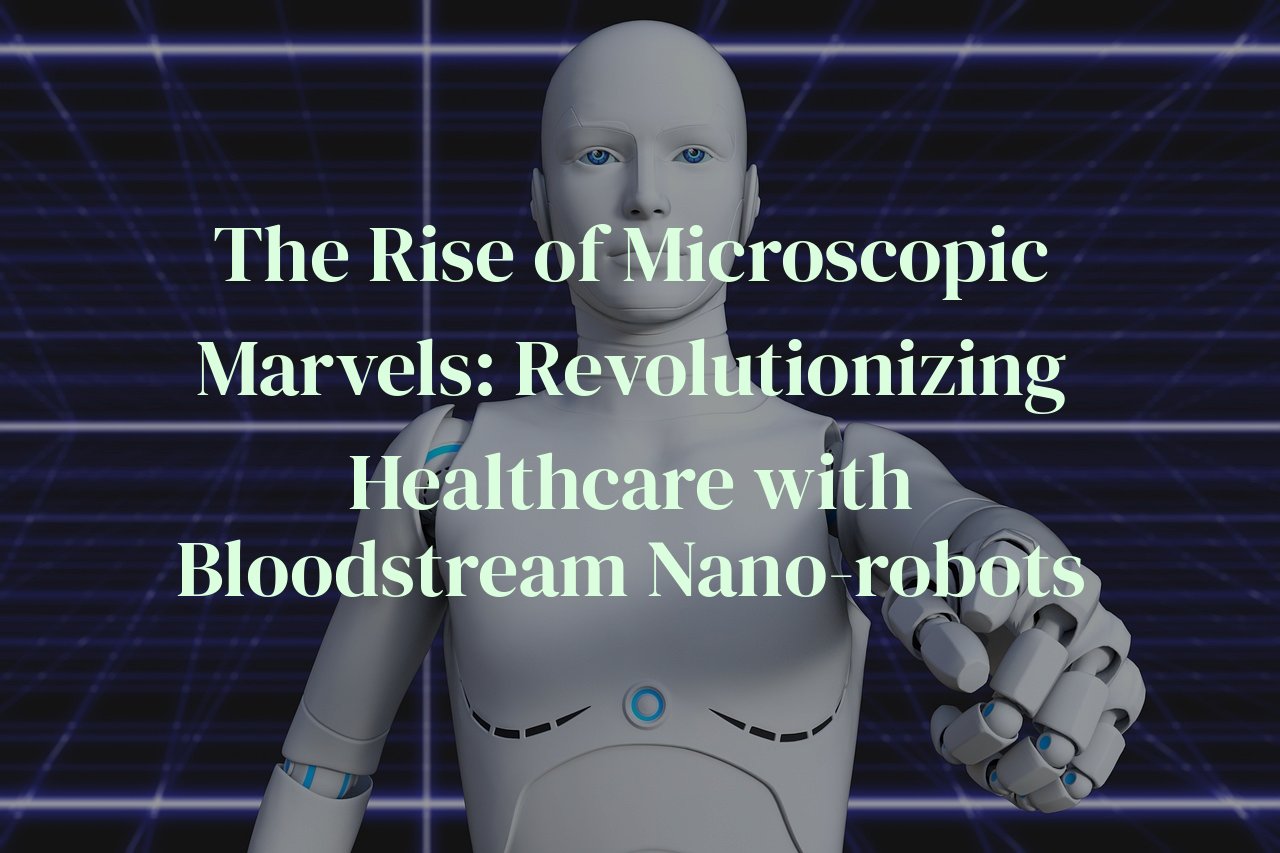
The realm of medical science is on the brink of a revolution, one that could transform the very essence of treatment and diagnostics. As a professional in medicine and health common sense, with a specialized interest in dietary therapy, I’ve closely watched the burgeoning field of nano-robots and its potential to refine precision medicine. In this comprehensive exploration, we’ll delve into the innovative world of nano-robots within our circulatory system and how they promise to redefine patient-specific healthcare.
By journeying through this post, you will unearth the profound implications of nano-robot technology for conditions ranging from cancer to heart disease, and how it stands to offer unparalleled tailoring of medical interventions. Discover not only the science behind these minute medical marvels but also how they may eventually impact our approach to treatment and wellness, bringing the idea of science fiction to our very real present and future.
Table of Contents
Demystifying Nano-robots: An Introductory Primer
The dawn of microscopic marvels ushering a new era in healthcare whispers promises of a tomorrow that reads like science fiction. Imagine tiny, intelligent machines, nano-robots, coursing through our blood, mending cells, hunting malicious entities, and dispensing medicine so precisely that side effects become whispers of a cumbersome past. Whether I’m attending a bustling conference or sipping on green tea while the rain serenades my study’s window, the thought of nano-robots swimming in my bloodstream ignites a curious mix of awe and a pressing need to understand these infinitesimal warriors better.
Let’s sketch out a primer, shall we? Nano-robots are, essentially, molecular machines that can operate within the human body. Envisage them as miniature submarines navigating the red sea of our blood, except these vessels are made of biocompatible materials and are often just a few nanometers wide—smaller than a blood cell. They’re designed to perform specific tasks, such as targeting cancerous cells for treatment or monitoring glucose levels in real time.
For instance, coming from a personal place, a family history riddled with diabetes makes the glucose-monitoring nano-bots a poignant subject. These bots are like vigilant sentinels, potentially revolutionizing diabetes management, thereby avoiding those incessant finger pricks that my Aunt Martha would so often lament over. Furthermore, drug-delivery nano-robots that I lovingly dub ‘pharmacy cruisers’ encapsulate therapeutic substances and release them at the precise site of the ailment, minimizing systemic effects and maximizing treatment efficacy.
It is not just about disease control; we are looking at potential health optimizers—one might even humor the thought of nano-robots augmenting our well-being, enhancing cognitive functions, or perhaps repairing tissues. As my research deepens and patient testimonies burgeon, the layers enveloping nano-robotic technology unravel, revealing not just cutting-edge science, but a tapestry of hope for countless individuals.
Yet, when discussing these minuscule miracles, it’s crucial to ground ourselves in reality. For all the excitement that wraps around conversations at symposiums or coffee-fueled debates post-dinner with colleagues, the application of nano-robots in healthcare remains nascent. It festoons the horizon of tomorrow, signaling profound change. I often muse over the brilliance of these microscopic marvels as I hear the heartbeat of the medical community pulsating with fervent anticipation for what these bloodborne nano-navigators could unravel for humanity’s future wellbeing.
Navigating the Vein Highways: Precision Medicine in Action
The term ‘precision medicine’ became more than just a medical buzzword the day nano-robots embarked upon their first successful journey through the intricate network of a human’s veins. Whenever I recount my first encounter with the concept, it evokes a sense of science fiction turning into science fact. Nano-robots in the bloodstream resemble a fleet of microscopic submarines, each programmed with a mission to target specific sites within the body, delivering drugs with unparalleled precision, locating and obliterating tumors, or repairing damaged tissues on a cellular level.
Describing how these nano-robots navigate our ‘vein highways’ is like narrating an epic saga of miniaturized prowess. Utilizing the body’s own biomarkers as road signs, these nimble travelers adjust their routes in real-time, responding to the ebbs and flows of biochemical signals. They’re equipped with sensors so sophisticated that they can distinguish between the subtle nuances of healthy and diseased cells. This level of discernment opens up possibilities for targeted therapies that I could hardly have imagined when I began my career.
The peak of their journey is not just the destination but the process itself. As they course through the bloodstream, nano-robots communicate with each other, sharing vital data, ensuring a synchronized attack on pathogens or an orchestrated release of medication. This networked intelligence is akin to a hive mind, where the collective actions produce outcomes more significant than any individual element could achieve alone.
Being witness to these advancements, I’ve been both humbled and awestruck. The awe resides not only in what nano-robots can do today but in their untapped potential for tomorrow. These navigational marvels have initiated a novel paradigm in precision medicine, one where the patient’s internal landscape becomes a vast yet conquerable territory for clinical intervention.
And as with all journeys, unforeseen obstacles arise. Nano-robots must be designed to avoid triggering immune responses, to degrade safely within the body, and to be commanded with precision that avoids collateral damage. Despite the complexity, these challenges are gradually being overcome through meticulous research and innovative engineering, paving the way for a future where health is not just managed but meticulously sculpted at the microscopic level.
The Frontline against Illness: Nano-robots in Disease Treatment
The advent of nano-robots in the realm of healthcare isn’t just another passing trend; it’s an evolution that promises to redefine our approach to disease treatment. Imagine these microscopic marvels roaming through your bloodstream, acting as vigilant guardians against a myriad of health adversaries. As a healthcare enthusiast, the potential of these tiny warriors fills me with a sense of awe and deep respect for the ingenuity of medical science.
In the battle against diseases, nano-robots present unprecedented precision. Envision them as targeted missile systems, homing in on cancerous cells to deliver chemotherapy directly into the malignant tissue, sparing the healthy cells and mitigating side effects. These nano-agents could rightfully revolutionize oncology, transforming it from an often-debilitating treatment process into a more tolerable and efficient one.
But it doesn’t end with cancer. Nano-robots offer a beacon of hope for individuals living with chronic conditions, such as diabetes. Instead of constant monitoring and self-regulating insulin levels, these minuscule machines could be designed to detect glucose spikes and autonomously release insulin, maintaining balance with little to no patient effort. The possibility of automating such bodily responses to chronic illnesses could vastly improve the quality of life and patient autonomy.
Moreover, in infectious diseases, nano-robots can be tailored to pinpoint pathogens and deliver antiviral or antibiotic agents right where they are needed most. In a world where antibiotic resistance is a mounting concern, the specificity of nano-robots could not only enhance treatment efficacy but also contribute to curbing the misuse of broad-spectrum antibiotics and the subsequent emergence of superbugs.
Despite these tantalizing prospects, we must navigate the complex ethical, safety, and technical challenges. As with all great scientific advances, the frontier of nano-robotics also presents a myriad of unknowns that we must approach with caution. Nevertheless, the potential for these microscopic marvels to act as the frontline against disease is a narrative of hope that aligns with our deepest aspirations for a healthier tomorrow. A future where we stand tall, not just as survivors of our ailments, but as champions in control of our own health narratives, thanks to the aid of our nano-sized allies.
Challenges and Considerations: Ethics, Safety, and the Future
In my years of exploring the fascinating interplay between technology and health, the ethical, safety, and future considerations of deploying nano-robots in the bloodstream have always intrigued me. As we edge closer to making this once science-fiction fantasy a reality, it is crucial to recognize the manifold challenges that accompany such a revolutionary shift in healthcare delivery.
From an ethical standpoint, the personal biodata collected by these microscopic marvels raises concerns about privacy and consent. Who lays claim to this intimate biological intel? The potential for misuse in a world hungry for data could lead to unprecedented breaches of personal autonomy. Moreover, the sanctity of the human body, often considered inviolable, is brought into question when introducing man-made entities into such a personal space.
Safety is another terrain fraught with unknowns. Nano-robots would have to be rigorously tested to ensure they do not inadvertently harm the very patients they seek to heal. Questions about long-term side effects, the possibility of immune system reactions, and the protocols for the safe disposal of these nano-entities after their job is done, all loom large. The horizon of our knowledge stretches far, but these tiny travelers take us into uncharted waters, demanding new standards of biocompatibility and control.
Looking to the future, the trajectory of nano-robotics in medicine is as thrilling as it is uncertain. Will we see a democratization of healthcare, with these devices leading to early disease detection and treatment for all? Or could we witness a chasm widen between those who can afford such cutting-edge treatment and those who cannot? The legacy of healthcare inequality casts a long shadow, even over our brightest innovations.
This juncture in our journey represents a convergence of innovation with humanity’s deepest values. As we advance toward integrating nano-robots into our healing protocols, we must navigate the ethical quandaries, demand stringent safety protocols, and consciously craft our healthcare future. I remain awed by the promise these microscopic marvels hold, and equally vigilant of the weighty considerations they bring to the fore.
Personalizing Health: Nano-robots Tailoring Individual Care
In the ever-evolving tapestry of medical innovation, the integration of nano-robots within our bloodstream represents not just a leap, but a quantum jump in personalizing healthcare. My enthusiasm for this pioneering frontier cannot be overstated—having closely followed the journey from conceptual sketches on science journals to the precipice of real-world application.
Imagine a world where your body’s unique chemistry and genetic make-up are the guiding stars for your treatment. Nano-robots, with their capacity to decipher our physiological codex, will be at the vanguard of this new era. Diagnostics that once required bulky machinery and invasive procedures could be conducted by these microscopic agents, relentlessly and meticulously surveying every nook and cranny of our vascular network. They would detect deviations from the norm—be it a spike in a biomarker or a subtle shift in protein expression—ushering in prompt, personalized interventions.
Once the preserve of generalist approaches, treatments could now be tailored down to the molecular level. Picture a fleet of nano-robots, each designed to harmonize with a patient’s cellular landscape, delivering medication directly to the affected tissues with surgical precision. This level of customization would drastically reduce adverse reactions and improve efficacy, rendering one-size-fits-all prescriptions obsolete.
Yet, as I delve deeper into this subject, my awareness of the profound ethical and safety implications grows. Still, amongst the alternating currents of concern and optimism, the potential for individualized wellbeing brought forth by these tiny titans fills me with a sense of cautious hope. They offer a beacon of light for chronic disease sufferers, countless of whom I’ve interacted with, yearning for therapies that are ‘just right’ for their unique battles.
As the dawn of bloodstream nano-robotics approaches, I’m gripped by the profound implications they herald for bespoke healthcare. Guided by this microscopic fleet, the future whispers promises of a world where treatments are intimately aligned with our individual needs—ushering in a new level of harmony between medicine and the human condition.
Conclusion
As we envision a future where tiny autonomous machines patrol our bloodstream, tackling diseases at their molecular roots, we stand on the cusp of medical innovation unlike any before. The journey through the intricacies of nano-robotic technology in this post reveals not only the immense potential but also the careful consideration required as we steer towards a more advanced, yet conscientious, approach to healthcare. Embrace the coming era where each of us may benefit from the precision and personalization promised by these microscopic defenders of health.



